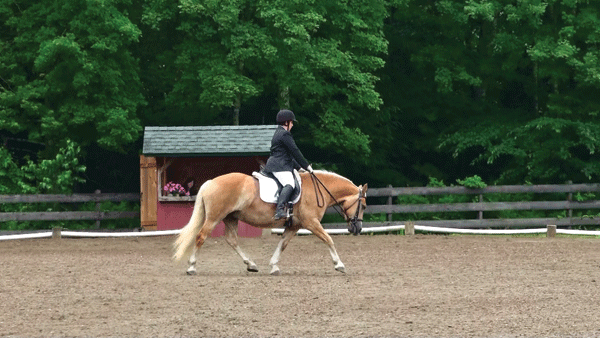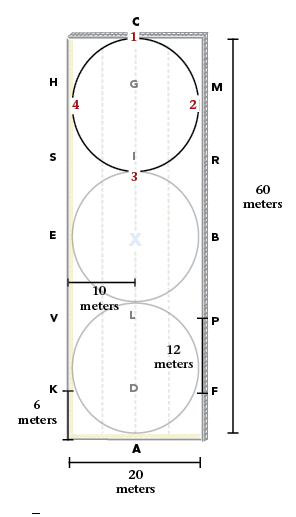
This picture shows Sherri Aharonian on her 16-year-old Haflinger/Belgian cross, Ben, riding a First Level test. Sherri has owned Ben for seven years, but both are relatively new to dressage. Sherri has shown in hunter classes and, she says, it is a challenge for her to sit upright and not pitch forward. Sherri describes Ben as having a wonderful temperament and a good work ethic. They are currently working on developing the canter and lengthenings of stride. He has been scoring consistently in the 70s, and his favorite movement is stretching on the circle.
For a First Level test, Ben shows a nice stretch forward and down, with enough activity and lift in his hind legs. However, I’d like to point out one of the challenges in Ben’s further training. Many Haflinger and Haflinger-cross breeds I have worked with have difficulty with collection in the canter and lengthening of the strides. Ben is active behind, but the motion of his hindquarters appears to go more up than under. He should step a little farther under the rider’s weight, thus becoming lighter and freer in his shoulders.
Watching Sherri post the trot, I can see how much she is focused on her task of showing Ben’s favorite movement and allowing him to stretch forward and down without dropping the contact. In her attempt to give him a frame but allow him to stretch as much as possible, Sherri is stretching her elbows. This can create tension in her shoulders.
Her balance line is a bit forward, which in this task is allowed. Analyzing this moment, I notice that this picture can give the impression that Ben is pulling her forward or leaning on her hands (even though I am positive that this is not the case). Sherri needs to learn how to encourage Ben to lower his hindquarters and transform his energy from a forward function to more of a weight-carrying function with balance. This shift in balance is a very fine line, as being even 1 millimeter off the goal can be considered a full miss. I would advise Sherri to imagine that her center of gravity is farther back and, to avoid the tension in her arms, allow the reins to slide through her fingers more, thus keeping her arms softer in her elbows.
Try this: Stand on the ground with equal weight on both feet. Next, shift your weight slowly more toward your heels. You will feel your arms want to lift up as a counterbalance. Now consider the horse’s situation. The neck and head act as a long lever. The longer the horse stretches, the more he needs to counterbalance with his head and neck. By keeping your own center of gravity farther back, you can make this easier for the horse. This can be a very tiny shift of weight, but it does help the horse to understand how to step more under the weight and become lighter in his shoulders. In training, Sherri should try to use her upper-body balance in rising and sitting trot—and later in the canter— to influence the rhythm and tempo of the trot. Performing the rising trot without stirrups can be very helpful in preventing the problem of pitching forward. It also can help to center her balance over the horse’s center of gravity. The movement of rising trot should begin inside the pelvis (lower abdominal muscles and deep hip muscles) rather than from her feet pushing down onto the stirrups (when riding with stirrups).
In the canter, riding many transitions will improve the elasticity, making this gait easier. For a horse like Ben, it is very important for him to stay in front of Sherri’s inside leg. To ensure this, I advise Sherri to ride all transitions with a slight shoulder-fore position. Riding on a circle in canter, Sherri can practice slowly making the circle smaller and beginning to collect the strides a bit. Just before this becomes too difficult, she should use her inside leg to ask Ben to enlarge the circle with more activity, thus encouraging a shoulder-fore position.
Working on elasticity and balance within the movement will keep Ben young as long as possible and hopefully allow the pair to move up more levels in dressage, too. Well done.
Susanne von Dietze is a leader in equestrian biomechanics. A physiotherapist, licensed Trainer A instructor and judge for dressage and show jumping, she gives lectures and seminars throughout the world, including at the prestigious German Riding Academy in Warendorf. She is a native of Germany and now lives with her husband and three children in Israel, where she competes at the international level. She is the author of two books on the biomechanics of riding: Balance in Movement and Horse and Rider, Back to Back. Find her books at HorseBooksEtc.com.











